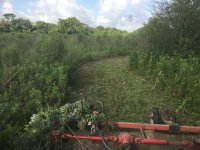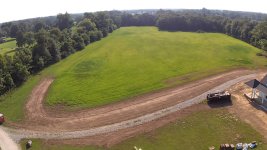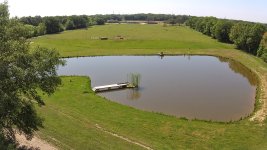Hire someone to cleanup your place that has the right size equipment the first time. Buy a 50-60 HP tractor with a good quality bushhog to maintain it. That way your costs won’t be out of site buying more tractor and bushhog than you need.
You are using an out of date browser. It may not display this or other websites correctly.
You should upgrade or use an alternative browser.
You should upgrade or use an alternative browser.
New member tractor advice
- Thread starter RHanna
- Start date
/ New member tractor advice
#71
Bentrim
Gold Member
- Joined
- Apr 22, 2020
- Messages
- 263
- Location
- York County, Pennsylvania
- Tractor
- Massey Ferguson 245, Massey Ferguson 14 Allis Chalmers G
Food for thought--
Many years ago when I worked for a farm equipment dealer, there were folks who would come in and ask if we had any old tractors really cheap. They stated they only wanted to pull some logs out of the woods and didn't want to spend more than a few hundred on a tractor.
The owner of the dealership would then ask if they expected it to run, the clutch, transmission, and the brakes to work. They always replied "well yeah", he then went on to explain that all these had to work for anyone to use the tractor so there are no "cheap" tractors.
A good eye can get you a tractor at a good price, even if the tractor looks rough, look under the paint, pull the dipstick, look for worn spots (levers, pedals hitch parts etc.) look close to see if it has been regularly serviced. Just as with art and old cars sometimes a little polishing bring out the beauty of the item.
Many years ago when I worked for a farm equipment dealer, there were folks who would come in and ask if we had any old tractors really cheap. They stated they only wanted to pull some logs out of the woods and didn't want to spend more than a few hundred on a tractor.
The owner of the dealership would then ask if they expected it to run, the clutch, transmission, and the brakes to work. They always replied "well yeah", he then went on to explain that all these had to work for anyone to use the tractor so there are no "cheap" tractors.
A good eye can get you a tractor at a good price, even if the tractor looks rough, look under the paint, pull the dipstick, look for worn spots (levers, pedals hitch parts etc.) look close to see if it has been regularly serviced. Just as with art and old cars sometimes a little polishing bring out the beauty of the item.
TexasMax
New member
- Joined
- Apr 16, 2021
- Messages
- 4
- Tractor
- Massey Ferguson 1135, Ford 7500 backhoe/loader, John Deere 300D, Ford 8N 52.
I purchased an older MF 1135, no front end loader since I have a Ford 7500 backhoe with loader. Retired, I just do what I feel like, when I feel like doing it. I bought a 16 ft used bushhog this year that only needed grease seals. I'm talking about 1970s equipment. The farm has about 180 acres, mostly cleared that needs cutting every year or two. This old equipment is as tough as an anvil. That old Perkins 6 cylinder diesel was the best investment I ever made. The batwing belongs to my nephew. If I can drive over it with the Massey, the bushing will cut it. Don't be afraid of old Tractors. Mine has been low maintenance but just remember to check and change oils/grease often and keep them clean after each use! They will last a lifetime if you do.
stuartdds
New member
My 33 acres was similar 6yrs ago (few saplings 2-3" diameter 8-10' tall). I purchased a Kubota M7060 with cab and FEL with 400hrs on it (financed at 1.7%) and a VERY used 12' rigid deck bushhog (paid $2k cash). I had never driven a tractor before so I had to learn quickly. I was able to knock it all down with the bucket and not tear up my tractor... just went really slowly.
After 2-3yrs or mowing a couple times a year it finally got good grass throughout. Hiring someone to cut ditches for better drainage was critical. I maintain a lot of it with my 60" zero-turn, but use the bushhog 3-4x a year now. Now we've got driveways, a house, a barn, cow pasture, and 2 ponds. I could've hired someone to do all that, but maintaining and improving my property would be impossible without a tractor.
My vote - hire out cutting it the first time to knock down the thick stuff, then buy a tractor with a cab, FEL, and 12-15' batwing to maintain.
After 2-3yrs or mowing a couple times a year it finally got good grass throughout. Hiring someone to cut ditches for better drainage was critical. I maintain a lot of it with my 60" zero-turn, but use the bushhog 3-4x a year now. Now we've got driveways, a house, a barn, cow pasture, and 2 ponds. I could've hired someone to do all that, but maintaining and improving my property would be impossible without a tractor.
My vote - hire out cutting it the first time to knock down the thick stuff, then buy a tractor with a cab, FEL, and 12-15' batwing to maintain.
Attachments
John_Mc
Elite Member
- Joined
- Aug 11, 2001
- Messages
- 4,206
- Location
- Monkton, Vermont
- Tractor
- NH TC33D Modified with belly pan, limb risers & FOPS. Honda Pioneer 520 & antique Coot UTV
You might want to consider an alternate approach. Reading between the lines of your post (and I'll admit I may be way off here), it doesn't sound as though you are primarily concerned with earning income from the acres you would be mowing (such as haying it, or renting it out to someone who would hay it). You mentioned hunting. You'll attract a greater variety of wildlife by not keeping the entire 60-80 acres mowed down to grass the whole time. I have a small section of my land that was once pasture. I mowed it a couple of time per year for the first few years, wanting to keep it open. However, for the past 15+ years I've switched to a rotational mowing scheme: I mow 1/3 of the field once each year, then the next year I switch to another 1/3, and the final 1/3 the following year. Then I start over. I don't always break down the thirds exactly the same way. (Some times I do, some times I don't.) I do keep a few trails through the area mowed regularly. Occasionally, depending on how things are growing, I might skip a year entirely. Any mowing I do in this area is usually in the fall (other than trail mowing) - outside of the nesting season for ground-nesting birds
The goal is to keep the area in a variety of grassland/shrubland/sapling states, providing a much richer variety of habitat for wildlife. I have about 130 acres of mature woods adjacent to these rotationally mowed areas which provides different habitat. Neighboring farms have the pure grassland habitat well covered with their hay fields, so I don.t see the need to reproduce that in any large quantity on my own land. This rotationally mowed area still feels very open, and even something that has not been mowed in 3 years is still well within the capabilities of my 33 HP tractor and 5' medium duty brush mower. (In fact, as long as I haven;t let them get too big, I find mowing a field of fairly dense 3/4" diameter saplings takes significantly less horsepower than mowing a lush field of tall grasses.)
In your situation, you may want to mow the whole thing initially, especially if it's been a while. Though even then I'd urge holding off one one chunk of it for at least a year so as not to completely wipe out that habitat all at once. Let some of your first year mowing grow up for a year or so before going back and cutting the part you skipped the first time around.
If mowing for wildlife is something that interests you, it also may change your approach to equipment: Mowing 20 or 25 acres once (or maybe twice) a year is a whole different world than mowing 60-80 acres two or three times a year. You may want to hire someone to do that initial mowing for the first year or two, but after that, you can easily keep up with things with much smaller, less expensive equipment. I can mow a couple of acres an hour with my set up - maybe down to 1.5 acres/hour if things are really dense. I actually enjoy the time I spend on the tractor mowing. However, I'll admit it helps that I'm not doing anything near 60 acres.
Regardless of what strategy you choose, the size equipment you end up with will depend on your own personal preference for trade off between spending more time or spending more money. 20 acres with my compact tractor would be 10 hours of mowing in my conditions. If there were a lot of obstacles (rocks, trees, etc.), it would take me a bit more. a 40 HP tractor with a 7' brush hog would speed things up a bit: probably around 3 acres per hour.
For me, the added benefit of rotational mowing is that it frees up a lot of time for me to work in the woods, which is really where I like spending my time: harvesting firewood or saw logs for a project (usually bartered with a neighbor), improving wildlife habitat and timber growth, and maintaining our trail system
The goal is to keep the area in a variety of grassland/shrubland/sapling states, providing a much richer variety of habitat for wildlife. I have about 130 acres of mature woods adjacent to these rotationally mowed areas which provides different habitat. Neighboring farms have the pure grassland habitat well covered with their hay fields, so I don.t see the need to reproduce that in any large quantity on my own land. This rotationally mowed area still feels very open, and even something that has not been mowed in 3 years is still well within the capabilities of my 33 HP tractor and 5' medium duty brush mower. (In fact, as long as I haven;t let them get too big, I find mowing a field of fairly dense 3/4" diameter saplings takes significantly less horsepower than mowing a lush field of tall grasses.)
In your situation, you may want to mow the whole thing initially, especially if it's been a while. Though even then I'd urge holding off one one chunk of it for at least a year so as not to completely wipe out that habitat all at once. Let some of your first year mowing grow up for a year or so before going back and cutting the part you skipped the first time around.
If mowing for wildlife is something that interests you, it also may change your approach to equipment: Mowing 20 or 25 acres once (or maybe twice) a year is a whole different world than mowing 60-80 acres two or three times a year. You may want to hire someone to do that initial mowing for the first year or two, but after that, you can easily keep up with things with much smaller, less expensive equipment. I can mow a couple of acres an hour with my set up - maybe down to 1.5 acres/hour if things are really dense. I actually enjoy the time I spend on the tractor mowing. However, I'll admit it helps that I'm not doing anything near 60 acres.
Regardless of what strategy you choose, the size equipment you end up with will depend on your own personal preference for trade off between spending more time or spending more money. 20 acres with my compact tractor would be 10 hours of mowing in my conditions. If there were a lot of obstacles (rocks, trees, etc.), it would take me a bit more. a 40 HP tractor with a 7' brush hog would speed things up a bit: probably around 3 acres per hour.
For me, the added benefit of rotational mowing is that it frees up a lot of time for me to work in the woods, which is really where I like spending my time: harvesting firewood or saw logs for a project (usually bartered with a neighbor), improving wildlife habitat and timber growth, and maintaining our trail system
paulsharvey
Elite Member
I am no expert, so I'm a bit reluctant to suggest it, and it will be Ugly for 2 or 3 months, but controlled burns can be your friend. Kills off that brush, allows grasses to take back over. Then you can mow as desired. I would Not just randomly take the weed burner out there, but I would want to talk to the ag extension or someone for input first.
For hunting purposes, I would want some 8-12 ft wide mowed areas (maybe a couple times per year) meandering though mixed medium high grasses (3-6 ft), and some thicker areas, but not jungle or hay field style.
For hunting purposes, I would want some 8-12 ft wide mowed areas (maybe a couple times per year) meandering though mixed medium high grasses (3-6 ft), and some thicker areas, but not jungle or hay field style.
Bobrown14
Gold Member
LS MT3 with a cab and a 72" brush hog + 72" rear tiller + delivery from OK to Upstate NY for 31K$ with 20 hrs onit.
It was big when I first got it - we have 30 acres with 2 wood lots and fields that were left go for 15 years-ish so brush as high as the cab or higher. I can drive right thru the brush with the brush hog and take it down.
There are some trees/saplings that I cant cut with the rotary cutter but I just knock them down with my FEL and use a chain and put them on a brush pile to burn later.
Brush hog the fields 3x a year. Trying to clear the fields of brush to eventually grow grass which is mostly still there once the brush is cleared. Used to be grass fields for milk cows 40 years ago.
Also use the tractor to till food plots and push snow (1/4 mile driveway on a mountain so high).
Never lamented getting a cab with heat and AC - or a bigger tractor than I probably needed originally.
Specially loved the cab when brush hogging brush with hornets nests in them. Woowee soooo glad I didn't have the windows open.
Also sooo glad for a cab pushing snow when its -20F cold af and at night and snowing cant see my hand in front of me hard.
There are a few farmers around me with tractors without cabs - I never see them working in the summer or winter.
It was big when I first got it - we have 30 acres with 2 wood lots and fields that were left go for 15 years-ish so brush as high as the cab or higher. I can drive right thru the brush with the brush hog and take it down.
There are some trees/saplings that I cant cut with the rotary cutter but I just knock them down with my FEL and use a chain and put them on a brush pile to burn later.
Brush hog the fields 3x a year. Trying to clear the fields of brush to eventually grow grass which is mostly still there once the brush is cleared. Used to be grass fields for milk cows 40 years ago.
Also use the tractor to till food plots and push snow (1/4 mile driveway on a mountain so high).
Never lamented getting a cab with heat and AC - or a bigger tractor than I probably needed originally.
Specially loved the cab when brush hogging brush with hornets nests in them. Woowee soooo glad I didn't have the windows open.
Also sooo glad for a cab pushing snow when its -20F cold af and at night and snowing cant see my hand in front of me hard.
There are a few farmers around me with tractors without cabs - I never see them working in the summer or winter.
Paul McILwain
Member
- Joined
- Sep 26, 2022
- Messages
- 25
- Tractor
- LS 5030C/MF220-4/ Satoh S650
An older jd 3020 and 6 or 8 foot bush hog for the small fields with saplings and an older 9 foot haybine, I have an international 1190 that is bullet proof for the other fields. I also have an older (70’s) versatile swather with 20 foot header and cab that I paid $500 for 10 years ago and still going strong for cutting trash fields. I use a ls5030c with cab and loader with Mitsubishi 58hp pre def engine for hay and snow with rear 6 foot blower
Flogger
Silver Member
I mow with a Massey MF 40 construction tractor. It has it's problems but it does the job every time I ask it to. It has a loader and is built like a Sherman tank. I assure you mowing 30 acres with a 6' mower is like a lifetime commitment though! Luck me I also have a 12' swather that more than cuts the time in half.



